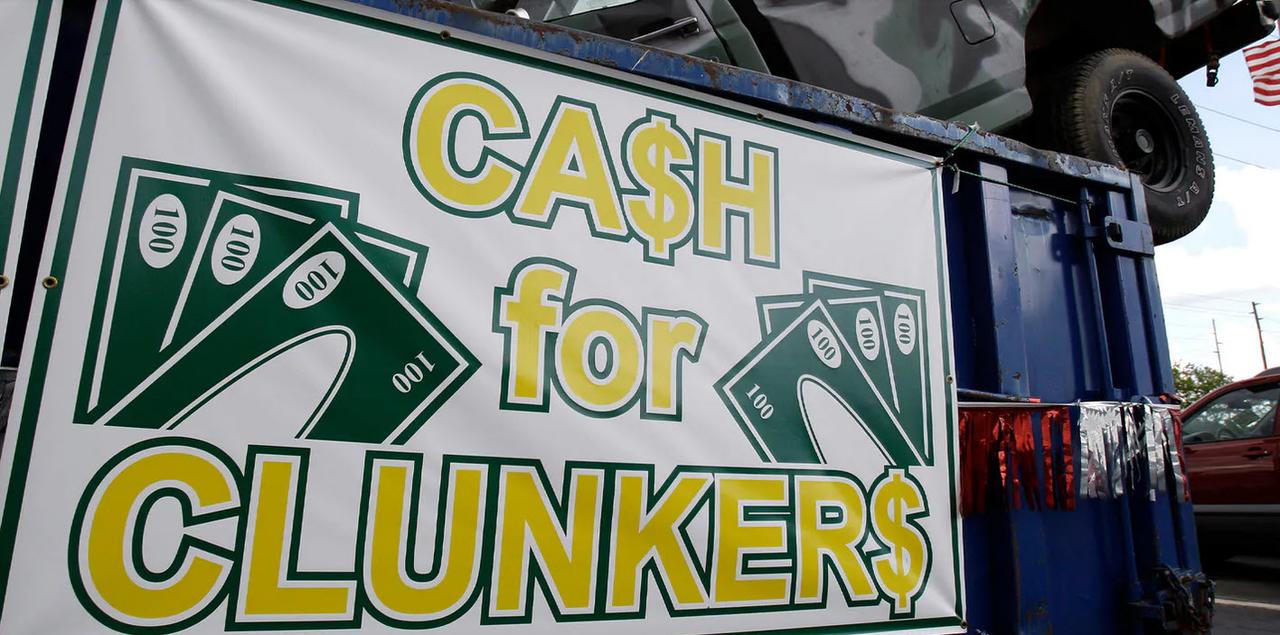Ford Wants A Repeat Of “Cash For Clunkers” As New Car Sales Tank
Authored by Rob Stumpf, via The Drive,
The coronavirus pandemic has left no part of the global economy untouched. People are staying indoors, businesses are shuttering left and right, unemployment is skyrocketing and virtually nobody is buying cars. Now, as we edge toward a downturn worse than the 2008 financial crisis, Ford is nudging the U.S. government toward another Cash for Clunkers-style car buying incentive program.
“We think some level of stimulus somewhere on the other side of this would help not only the auto industry and our dealers, which are a huge part of our overall economy, but will help the customers as well,” said Mark LaNeve, Ford’s vice president of U.S. marketing, sales and service, in a phone interview with Bloomberg. “We’re in discussions about what would be the most appropriate.”
After the U.S. auto industry got its $80 billion taxpayer-funded bailout (minus Ford, which survived through private loans), a $3 billion taxpayer-funded initiative called the Car Allowance Rebate System (CARS) was signed into law, aimed at promoting consumers to trade in their old “clunkers” and purchase a brand new vehicle—ideally a cleaner and more fuel-efficient one. Anyone who owned a car built after 1984 with a rating of 18 MPG or less could be given a voucher worth between $2,900 and $4,500 toward their new car. Their old vehicle would then be disabled and taken out of circulation.
The program was nicknamed Cash for Clunkers and on the surface, it was a politician’s dream; better cars, more jobs, a boost to the economy, and an overall less harmful environmental impact.
Consumers bit the hook and auto sales immediately spiked. In total, 677,842 cars and trucks got traded in under the CARS program, totaling vouchers worth $2.85 billion. Fast forward 11 years and Ford is looking for a repeat.
“Cash for clunkers was very effective at that time,” LaNeve told Bloomberg. “It would be nice to think we could have something equally as effective for 2020 when we get out of this because it was a great program.”
Except, it wasn’t really a great program.
While Cash for Clunkers did result in a significant number of new cars parked in the driveway of Americans, the spike was brief. In fact, the program ran out of its initial $1 billion in funding within a month, prompting the U.S. government to provide another $2 billion influx. Its second round of funding was exhausted in just 17 days.
Economists also believe that sales weren’t really sustainable, and that instead of generating new transactions, it instead pulled forward later sales “from a far more distant future” by consumers who were already in the market for new vehicles.
Statistics indicate that the program benefited wealthier and better educated Americans more than it did lower income people. The idea that the program would create more jobs was correct, though not nearly as much as a reduction of payroll tax or an increase in unemployment aid.
It also wasn’t really that great for American automakers. Despite domestic cars representing at least 71.8 percent of all trade-ins, Detroit accounted for just 32.6 percent of all new car sales and leases under the CARS program.
Furthermore, the program took a substantial number of decent used cars off the road, many of which were still operable and roadworthy that could have been bought by lower-income families who live in areas where public transportation infrastructure is lacking. Instead, the vehicles exchanged under the program were destroyed.
It was the dealership’s responsibility to disable the vehicle’s engine after trade-in. This was typically done with a few quarts of sodium silicate solution (water, silica, and salt) and a minute or so of flat-footed revving until the inevitable seizure of ill-lubricated metal components was achieved. Disabled vehicles were then sent to recycling facilities where they would be crushed or shredded.
[youtube https://www.youtube.com/watch?v=X0IcIxhd8ks]
It’s worth noting that enthusiast vehicles suffered in this, too. Rare rides like the 1987 Buick ASC GNX and 1992 GMC Typhoon were sent to the crusher, though other fan favorites were also disposed off, including a BMW M3, 123 examples of the Subaru SVX, 381 Nissan 300ZXs and even four MK4 Toyota Supras. (One imagines Bring a Trailer would take care of many of those today.)
So in the end, Cash for Clunkers was a limited, mixed success at best. It was certainly a clever idea and a well-intentioned one, but if it happened again, some fine-tuning would absolutely need to be in order.
Having said all that, Ford hasn’t officially solicited the U.S. government for this type of assistance—yet. Politicians are aware of the thought, though no movement appears to have been made in either direction at this time. Via Bloomberg once more:
U.S. Representative Debbie Dingell, a Michigan Democrat whose district is home to Ford’s headquarters, said a vehicle scrappage or purchase incentive to spur demand has been discussed as a possible form of relief for the industry, but said no consensus has been reached on the issue.
“It’s out there as an idea along with many other ideas,” she said. “We’re working with the entire ecosystem of automakers, workers, their unions, suppliers, dealers and consumers.”
There’s no denying that the auto industry will need to perk up in the future. Even before the global pandemic, the industry was already slowing for its fifth consecutive year. It’s difficult to say what the correct next move will be, especially while manufacturing plants across the nation are idled and unemployment has skyrocketed, but surely there’s a better answer than clunkernomics.
Tyler Durden
Sun, 04/05/2020 – 10:30![]()
Zero Hedge’s mission is to widen the scope of financial, economic and political information available to the professional investing public, to skeptically examine and, where necessary, attack the flaccid institution that financial journalism has become, to liberate oppressed knowledge, to provide analysis uninhibited by political constraint and to facilitate information’s unending quest for freedom. Visit https://www.zerohedge.com




